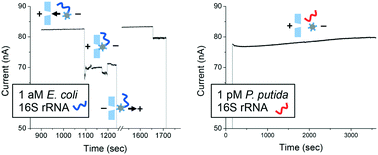Our official English website, www.x-mol.net, welcomes your
feedback! (Note: you will need to create a separate account there.)
Amplification-free, sequence-specific 16S rRNA detection at 1 aM†‡
Lab on a Chip ( IF 6.1 ) Pub Date : 2018-07-02 00:00:00 , DOI: 10.1039/c8lc00452h Bonhye Koo 1, 2, 3, 4 , Allison M. Yorita 1, 2, 3, 4 , Jacob J. Schmidt 2, 3, 4, 5 , Harold G. Monbouquette 1, 2, 3, 4
Lab on a Chip ( IF 6.1 ) Pub Date : 2018-07-02 00:00:00 , DOI: 10.1039/c8lc00452h Bonhye Koo 1, 2, 3, 4 , Allison M. Yorita 1, 2, 3, 4 , Jacob J. Schmidt 2, 3, 4, 5 , Harold G. Monbouquette 1, 2, 3, 4
Affiliation

|
A nucleic acid amplification-free, optics-free platform has been demonstrated for sequence-specific detection of Escherichia coli (E. coli) 16S rRNA at 1 aM (10−18 M) against a 106-fold (1 pM) background of Pseudomonas putida (P. putida) RNA. This work was driven by the need for simple, rapid, and low cost means for species-specific bacterial detection at low concentration. Our simple, conductometric sensing device functioned by detecting blockage of a nanopore fabricated in a sub-micron-thick glass membrane. Upon sequence-specific binding of target 16S rRNA, otherwise charge-neutral, PNA oligonucleotide probe-polystyrene bead conjugates become electrophoretically mobile and are driven to the glass nanopore of lesser diameter, which is blocked, thereby generating a large, sustained and readily observable step decrease in ionic current. No false positive signals were observed with P. putida RNA when this device was configured to detect E. coli 16S rRNA. Also, when a universal PNA probe complementary to the 16S rRNA of both E. coli and P. putida was conjugated to beads, a positive response to rRNA of both bacterial species was observed. Finally, the device readily detected E. coli at 10 CFU mL−1 in a 1 mL sample, also against a million-fold background of viable P. putida. These results suggest that this new device may serve as the basis for small, portable, low power, and low-cost systems for rapid detection of specific bacterial species in clinical samples, food, and water.
中文翻译:

扩增的免费的,序列特异性的16S rRNA检测在上午01点†往最‡
的核酸扩增自由,无光学平台已经证明用于序列特异性检测大肠杆菌(大肠杆菌)的16S rRNA在上午01点(10 -18 M)对10 6的倍(下午1点)背景恶臭假单胞菌(恶臭假单胞菌)RNA。需要简单,快速和低成本的方法来进行低浓度物种特异性细菌检测,从而推动了这项工作。我们的简单电导传感设备通过检测亚微米级玻璃膜中制造的纳米孔的阻塞来发挥作用。在与靶标16S rRNA序列特异性结合后,否则电荷中性,PNA寡核苷酸探针-聚苯乙烯珠共轭物将电泳移动并被驱动至较小直径的玻璃纳米孔,从而被封闭,从而产生较大,持续且易于观察的步骤降低离子电流。当此设备配置为检测大肠杆菌时,未发现恶臭假单胞菌RNA的假阳性信号16S rRNA。同样,当与大肠杆菌和恶臭假单胞菌的16S rRNA互补的通用PNA探针与小珠缀合时,观察到对两种细菌的rRNA都有阳性反应。最后,该设备还可以在百万倍的恶臭假单胞菌背景下,在1 mL样品中轻松检测到10 CFU mL -1的大肠杆菌。这些结果表明,该新设备可作为小型,便携式,低功耗和低成本系统的基础,以快速检测临床样品,食物和水中的特定细菌种类。
更新日期:2018-07-02
中文翻译:

扩增的免费的,序列特异性的16S rRNA检测在上午01点†往最‡
的核酸扩增自由,无光学平台已经证明用于序列特异性检测大肠杆菌(大肠杆菌)的16S rRNA在上午01点(10 -18 M)对10 6的倍(下午1点)背景恶臭假单胞菌(恶臭假单胞菌)RNA。需要简单,快速和低成本的方法来进行低浓度物种特异性细菌检测,从而推动了这项工作。我们的简单电导传感设备通过检测亚微米级玻璃膜中制造的纳米孔的阻塞来发挥作用。在与靶标16S rRNA序列特异性结合后,否则电荷中性,PNA寡核苷酸探针-聚苯乙烯珠共轭物将电泳移动并被驱动至较小直径的玻璃纳米孔,从而被封闭,从而产生较大,持续且易于观察的步骤降低离子电流。当此设备配置为检测大肠杆菌时,未发现恶臭假单胞菌RNA的假阳性信号16S rRNA。同样,当与大肠杆菌和恶臭假单胞菌的16S rRNA互补的通用PNA探针与小珠缀合时,观察到对两种细菌的rRNA都有阳性反应。最后,该设备还可以在百万倍的恶臭假单胞菌背景下,在1 mL样品中轻松检测到10 CFU mL -1的大肠杆菌。这些结果表明,该新设备可作为小型,便携式,低功耗和低成本系统的基础,以快速检测临床样品,食物和水中的特定细菌种类。











































 京公网安备 11010802027423号
京公网安备 11010802027423号